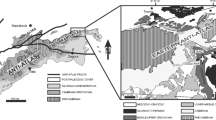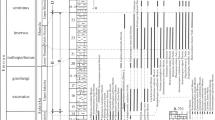Abstract
The Emsian–Eifelian succession of NW Spain contains an abundant and diverse bryozoan fauna, fenestrates being the most outstanding group. The Fenestellidae of the Moniello Formation (upper Emsian–lower Eifelian, Asturias, NW Spain) comprise 13 species, four of which are new: Rectifenestella covae n. sp., Cavernella asturica n. sp., Hemitrypa adversa n. sp., and Hemitrypa terentei n. sp. The other species composing the assemblage studied are: Fenestella aff. parallela Hall, 1881, F. vera Ulrich, 1890, Rectifenestella pioneri (Krasnopeeva, 1935), Spinofenestella aff. antiqua (Goldfuss, 1826), S. estrellita (McKinney and Kříž, 1986), S. strigilla (McKinney and Kříž, 1986), Laxifenestella capillosa (Počta, 1894), Hemitrypa aff. tubulosa (Nekhoroshev, 1948), and Ptylopora aff. nodosa Hall, 1883. Taking into account species reported in previous studies, the assemblage of Fenestellidae of the Emsian–Eifelian of NW Spain is composed of nine genera and 21 species. This fauna shows affinities with that of the Lower Devonian of Bohemia and also to those of the Middle Devonian of North America, Russia, and Asia. C. asturica n. sp. is the earliest and westernmost reported species of the genus, which was previously known to occur in the Carboniferous and Permian rocks from Hungary to Tibet. H. adversa n. sp. is the only known species of Hemitrypa with autozooecial apertures placed on the inner surface of the cone; some of the specimens of H. adversa n. sp. collected in the Moniello Formation developed unusually flat colonies.












Similar content being viewed by others
References
Arbizu M, Méndez-Bedia I (2006) El patrimonio Natural y Cultural de Castrillón (Asturias): Geología, fósiles e historia minera. Trab Geol 26:73–91
Arbizu M, García-Alcalde JL, Garcia-López S, Méndez-Bedia I, Sánchez de Posada LC, Soto FM, Truyols M, Truyols J, Álvarez F, Méndez C, Menéndez JR (1979) Biostratigraphical study of the Moniello Formation (Cantabrian Mountains, Asturias, NW Spain). A contribution to the Lower/Middle Devonian Boundary Problem. Geol Palaeontol 13:103–124
Astrova GG, Morozova IP (1956) About systematics of the order Cryptostomata. Dokl Akad Nauk SSSR 110:661–664 (in Russian)
Bigey FP (1972) Présence de Ptilopora aff. bohemica (Bryozoaire cryptostome) dans le Dévonien du Sud-Est du Massif armoricain. Bull Soc Études Sci Anjou N.S. 8:15–22
Bigey FP (1985) Biogeography of Devonian Bryozoa. In: Nielsen C, Larwood GP (eds) Bryozoa: Ordovician to recent. Olsen and Olsen, Fredensborg, pp 9–23
Borg F (1926) Studies on recent cyclostomatous Bryozoa. Zool Bidr Uppsala 10:181–507
Condra GE (1902) New Bryozoa from the Coal Measures of Nebraska. Am Geol 30:337–359
Cuffey RJ, McKinney FK (1979) Devonian Bryozoa. Palaeontol Spec Pap 23:307–311
d’Orbigny A (1850) Prodrome de paléontologie stratigraphique universelle des animaux mollusques rayonnés, faisant suite ou cours élémentaire de paléontologie et géologie stratigraphique, vol 1. Victor Masson, Paris, p 392
Ehremberg CG (1831) Symbolae Physicae, seu icones et descriptiones corporum naturalium novorum aut minus cognitorum, quae ex itineribus per Libyam, Aegyptum, Nubiam, Dongalam, Syriam, Arabiam et Habessiniam studio annis 1820–25 redierunt. Pars Zoologica: v. 4, Animalia Evertebrata exclusis Insectis
Elias MK, Condra GE (1957) Fenestella from the Permian of West Texas. Geol Soc Am Mem 70:1–158
Ernst A (2010) Trepostome bryozoans from the Lower–Middle Devonian of NW Spain. Riv Ital Paleontol Stratigr 116:283–308
Ernst A (2011) Cryptostome (ptilodictyine and rhabdomesine) Bryozoa from the Lower Devonian of NW Spain. Palaeontographica (A) 293:147–183
Ernst A (2012) Fenestrate bryozoan fauna from the Lower–Middle Devonian of NW Spain. N Jb Geol Paläontol Abh 264:205–247
Ernst A (2013) Diversity dynamics and evolutionary patterns of Devonian Bryozoa. Palaeobiodivers Palaeoenviron 93:45–63
Ernst A, Buttler C (2012) Cystoporate bryozoans from the Lower–Middle Devonian of NW Spain. N Jb Geol Paläontol Abh 263:261–285
Ernst A, Schroeder S (2007) Stenolaemate bryozoans from the Middle Devonian of the Rhenish Slate Massif (Eifel, Germany). N Jb Geol Paläontol Abh 246:205–233
Ernst A, Dorsch T, Keller M (2011) A bryozoan fauna from the Santa Lucia Formation (Lower–Middle Devonian) of Cantabrian Mountains, NW Spain. Facies 57:301–329
Goldfuss A (1826–1833) Petrefacta Germaniae. Zoophytorum reliquiae. 1st part, 1st div. Arnz und Cie, Düsseldorf, 114 + XXXVIII p
Gorjunova RV, Weiss OB (2012) A new genus Acupipora gen nov. from the Upper Carboniferous of the East European Platform and problem of classification of bryozoans of the order Fenestellida. Paleontol J 46:16–18
Hageman S, McKinney FK (2010) Discrimination of fenestrate bryozoan genera in morphospace. Palaeontol Electron 13:1–43
Hall J (1881) Bryozoans of the Upper Heldelberg and Hamilton groups. Trans Albany (1883) 10:1–36
Hall J (1883) Bryozoans of the Upper Heldelberg and Hamilton groups. Trans Albany Inst 10:145–197
Hall J (1884) Bryozoans of the Hamilton group. Report of the State Geologist for the year, 1883. Weeds, Parsons and Co., Albany, pp 5–61
Hall J, Simson GB (1887) Corals and Bryozoa from the Lower Heldelberg, Upper Heldelberg and Hamilton groups. Geol Surv State N Y 6:265–288
Horowitz AS, Pachut JF, Anstey RL (1996) Devonian bryozoan diversity, extinctions and originations. J Paleontol 70:373–380
King W (1849) On some families and genera of corals. Ann Mag Nat Hist 2:388–390
Krasnopeeva P (1935) Bryozoans of the Middle and Upper Devonian of Altai. Mat Geol Zapad-Sibir Kraya 20:43–84 (In Russian)
Lonsdale W (1839) Corals. In: Murchison RI (ed) The Silurian system. Part 2. Organic remains. John Murray, London, pp 675–694
M’Coy F (1844) A synopsis of the characters of the Carboniferous limestone fossils of the Ireland. Dublin University Press, Dublin, p 207
McKinney FK (2009) Bryozoan-hydroid symbiosis and a new ichnogenus, Caupokeras. Ichnos 16:193–201
McKinney FK, Kříž J (1986) Lower Devonian Fenestrata (Bryozoa) of the Prague Basin, Barrandian Area, Bohemia, Czechoslovakia. Fieldiana Geol N.S. 15:1–90
Méndez-Bedia I, Soto F, Fernández-Martínez E (1994) Devonian reef types in the Cantabrian Mountains (NW Spain) and their faunal composition. Cour Forsch-Inst Senckenberg 172:161–183
Morozova IP (1960) Bryozoans from the Devonian of Kuznets and Minusin basins. Trudy Paleontol Inst Akad Nauk SSSR 86:1–172 (in Russian)
Morozova IP (1974) Revision of the genus Fenestella. Paleontol J 8:167–180
Morozova IP (2001) Bryozoans of the order Fenestellida. Trudy Paleontol Inst 277:1–176 (in Russian)
Morozova IP, Weiss OB, Racki G (2006) New Devonian and Carboniferous bryozoans of the Holy Cross Mountains (Central Poland). Paleontol J 40:529–540
Nekhoroshev VP (1926) Bryozoans of the Middle Devonian of NE Mongolia, with description of a microscopic method of study for fenestellids. Trudy Geol Muz Akad Nauk SSSR 1:1–28 (in Russian)
Nekhoroshev VP (1948) Bryozoans of the Devonian of Altai. Paleontologiya SSSR 3 (2,1). Izdat Akad Nauk SSSR Paleontol Inst 3(2,1):1–172 (in Russian)
Pérez-Estaún A, Bea F, Bastida F, Marcos A, Martínez-Catalán JR, Martínez-Poyatos D, Arenas F, Díaz-García F, Azor A, Simancas JF, González-Lodeiro F (2004) La Cordillera Varisca Europea. El Macizo Ibérico. In: Vera JA (ed) Geología de España. SGE-IGME, Madrid, pp 19–230
Phillips J (1841) Figures and descriptions of the Palaeozoic fossils of Cornwall, Devon, and west Somerset; observed in the course of the Ordinance Geological Survey of that district. Longman, Brown, Green and Longmans, London, xii + 231 p
Plamenskaya A (1991) Bryozoans of the Lower and Middle Devonian of Kazakhstan. In: Dubatolov VN, Stukalina GA (eds) Biostratigraphy of the Lower and Middle Devonian of the Djulgaro-Balkhash provinces. Akad Nauk SSSR Inst Geol Geof Novosibirsk 91–111 (in Russian)
Počta P (1894) Systême Silurien du Centre de la Bohême par Joachim Barrande. Première Partie: Recherches Paleontologiques, vol VIII. Tome 1, p 230
Prantl F (1928) Some bryozoans from the Koneprusy limestone (Bohemia). Třídy České Akad Ročnik XXXVII 10:1–3 (in Czech)
Prantl F (1932) Revision of Fenestellids from the Devonian of Bohemia. Palaeontogr Bohemiae XV:1–70 (in Czech, with French translation)
Schulga-Nesterenko MI (1951) Carboniferous fenestellids of the Russian Platform. Trudy Paleontol Inst Akad Nauk SSSR 32:1–161 (in Russian)
Snell JE (2004) Bryozoa from the Much Wenlock Limestone (Silurian) Formation of the West Midlands and Welsh Borderland. Monogr Palaeontogr Soc Lond Publ 621(157):1–110
Suárez Andrés JL (1998) Briozoos fenestrados de la formación Moniello (Devónico) en el área de Arnao. I: Fenestellidae. Rev Esp Paleontol 13:187–196
Suárez Andrés JL (1999a) Briozoos fenestrados de la formación Moniello (Devónico) en el área de Arnao. II: Septoporidae, Polyporidae y Acanthocladiidae. Rev Esp Paleontol N° Extr Homenaje Prof Truyols 185–193
Suárez Andrés JL (1999b) Nuevos datos sobre los briozoos devónicos de la Zona Cantábrica. Temas Geol-Min 6:643–646
Suárez Andrés JL (1999c) Parasitismo en briozoos del Devónico de la Zona Cantábrica. Temas Geol-Min 6:647–650
Suárez Andrés JL (2014) Bioclaustration in Devonian fenestrate bryozoans. The ichnogenus Caupokeras McKinney, 2009. Span J Paleontol 29:5–14
Suárez Andrés JL, González Álvarez C (2000) Fenestrapora Hall, 1885 (Bryozoa) del Devónico de la Zona Cantábrica. In: Díez JB, Balbino AC (eds) Actas I Congresso Ibérico de Paleontologia—XVI Jornadas Sociedad Española de Paleontología—VIII International Meeting of IGCP 421. Universidade de Évora, Évora, pp 293–294
Suárez Andrés JL, Wyse Jackson PN, Sendino C (2014) First record of a Palaeozoic fenestrate with a secondary zooid-bearing meshwork. In: Rosso A, Wyse Jackson PN, Porter J (eds) Bryozoan studies 2013. Studi Trent Sci Nat 94:241–247
Suárez-Andrés JL, Wyse Jackson PN (2014) Ernstipora mackinneyi, a new unique fenestrate bryozoan genus and species with an encrusting growth habit from the Emsian (Devonian) of NW Spain. N Jb Geol Paläontol Abh 271:229–242
Tavener-Smith R (1973) Fenestrate Bryozoa from the Visean of County Fermanagh, Ireland. Bull Brit Mus Nat Hist 23(7):1–493
Termier H, Termier G (1971) Bryozoaires du Paleozoique Superieur de l’Afghanistan. Doc Lab Géol Fac Sci Lyon 47:1–52
Ulrich EO (1890) Paleozoic Bryozoa. Ill Geol Surv 8:283–688
Volkova KN (1974) Devonian Bryozoa from the South-East Altai. Trudy Inst Geol Geofiz 199:1–182 (in Russian)
Acknowledgments
Covadonga González Álvarez is thanked for help with graphic work, and the late Ken McKinney (Boone) is thanked for discussion on the unusual morphology of Hemitrypa adversa, particularly on specimen NHMUK PI BZ 5834. This research received support from the SYNTHESYS Project http://www.synthesys.info/ ,which is financed by European Community Research Infrastructure Action under the FP7 “Capacities” Program, through a grant awarded to J.S. in 2012 (GB-TAF 2129) to visit the NHM (London). Paul D. Taylor (London) is thanked for SEM imaging of specimen NHMUK PI BZ 5834. Catherine Reid (University of Canterbury, Christchurch) and an anonymous reviewer are gratefully acknowledged for their helpful, constructive comments.
Author information
Authors and Affiliations
Corresponding author
Electronic supplementary material
Below is the link to the electronic supplementary material.
Rights and permissions
About this article
Cite this article
Suárez Andrés, J.L., Ernst, A. Lower–Middle Devonian Fenestellidae (Bryozoa) of NW Spain: implications for fenestrate palaeobiogeography. Facies 61, 415 (2015). https://doi.org/10.1007/s10347-014-0415-3
Received:
Accepted:
Published:
DOI: https://doi.org/10.1007/s10347-014-0415-3




